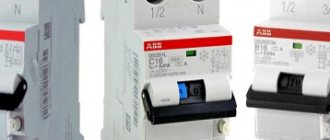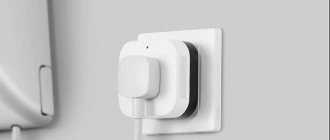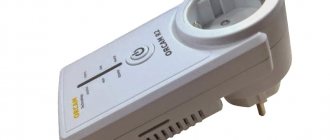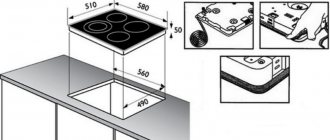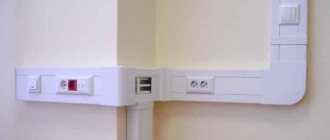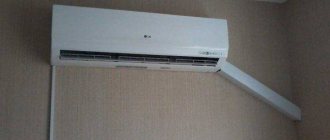Installation box for mounting a socket (socket box)
The installation box (socket box) is needed for two simple purposes - to ensure electrical safety and the strength of the mechanical fastening. If everything is clear with safety (insulation, so that there is no short circuit and no electric shock), then mechanical strength (so that the socket does not fall out of its place) is a problem that few people talk about.
The second part of the article on this topic is how to properly replace and connect a built-in socket.
I also spoke a little on this topic in an article about checking the quality of installation of new sockets.
And if you are at all interested in what I write about, subscribe to receive new articles and join the group on VK!
The main reasons contributing to the loss of sockets
The danger of using a connector hanging on the wires is manifested not only in the threat of electric shock to a person, but also in the likelihood of one of the wires breaking. This may be accompanied by a short circuit with another wire, which can lead to a loss of power in the house or failure of household appliances.
There are many reasons leading to such manifestations. These include childish pranks and carelessness of the owners, when the device can be torn out by getting caught in a portable large object (for example, when rearranging furniture). But there are two main factors that in most cases lead to electrical sockets falling out:
- non-compliance with installation rules;
- improper operation.
Both options involve several possible violations, so each should be considered in more detail.
Failure to comply with installation rules
Such violations include ignoring basic conditions that ensure reliable fixation of the socket in the wall:
- Refusal to use sub-units. Some users believe that such a detail is unnecessary, relying on the strength of the material from which the wall or partition is made. Indeed, the socket can hold quite firmly in the recess prepared for it, but any material will begin to wear out and crumble over time, which will first lead to its loosening and then to falling out. In this case, the recess itself may receive damage that will have to be repaired, expending additional effort.
Consequences of violating the rules for installing a socket and refusing to install a sub-socket
- Insufficient tightening of spacer tabs. The design of each mortise (internal) socket provides for the presence of fastening segments, which are tabs that expand when the screw is tightened. When installing the product into the wall, it may seem that the fastening is secure, but after some time, the connector will begin to wobble and fall out of the wall. This is a consequence of a weak strut.
If the screws are not tightened properly, the device will not be securely held in the wall.
- Using a regular outlet box on drywall. After several operations to turn the connector on/off, the product will fall out, damaging the partition.
Incorrect socket operation
The irresponsible attitude of users towards power points can also become a factor affecting the quality of their fixation at the installation site. Improper use may include:
- The use of old-style sockets (from the Soviet period) in combination with European standard electrical plugs. The fact is that the holes in old products have a smaller diameter than modern connectors, so the switching process is either completely eliminated or requires the use of significant physical effort, which will certainly lead to a violation of the fastening strength and falling out of the niche.
Old sockets don't fit well with modern electrical connectors
- Disconnecting the plug by pulling the wire. This method will very quickly lead to the product falling out of the wall, because the entry/exit of the electrical plug must occur at a right angle, and pulling by the wire changes this angle, turning axial extraction into lateral eversion. In addition, this method may disrupt the contact of the wire or even pull it out of the plug itself. Therefore, such a practice must be eliminated and its use must not be allowed in the future.
Do not remove the plug by pulling on the cord - this is a serious violation
The problem is that the socket does not stay in place, dangles and falls out of the wall.
The installation boxes that were used before (relatively speaking, Soviet ones) are not suitable for all new sockets. First of all, because of the fastening. The rosette has legs with sharp, scratchy tips that move apart. As a result, these spacer tabs should rest against the edges of the box, and the socket will be secured.
But this is definitely not enough, since a freshly replaced socket will come out with all the insides after turning the iron on and off several times. Because often the paws do not reach the socket, or do not hold well.
This is unworthy of an electrician, as if a professional photographer lost a flash drive with paid photographs of a wedding, as if the external unit of a split system fell off the wall after the installer left, or as a psychic could not determine from a photo whether a person is alive or dead.
If you are doing business, be a professional! But such annoying mistakes are unforgivable for a professional. Unfortunately, we have a lot of amateurs...
There are tips that for more reliable installation you need to straighten the legs more, or put something under them. For example, pieces of sandpaper, rubber, etc. But this is only a temporary measure, and with such additional fasteners, over time, the structure will still become loose, and the socket may break out of the socket box.
Of course, you need to follow a simple rule for removing the plug from the socket - be sure to hold the socket body with your other hand. But once this rule is not followed (for example, if it is a child), and that’s it - see the first photo, the socket does not stay in the box.
For switches the situation is much simpler; there are enough spacer legs. After all, no force is applied to them to pull them out.
And further. Some new sockets do not fit into the old sockets in depth. Even if you use an outlet without grounding.
Differences between old and new outlets
Switches installed in walls are attached using the same principle, but they fall out much less often. The reason is simple - when turning it on and off, the force is always applied in the direction of the wall. In sockets, everything is different - when the plug is inserted into them, the force is directed towards the wall, and when it is removed, it is directed back.
In older outlets, this problem was not so acute, because they were designed for devices with much lower power consumption. This automatically meant that there were no strict requirements for the pressing force of the contacts - plugs were inserted and removed from sockets with much less effort - from that time on, many users began the habit of pulling the plug by the cord. Removing the plug in this way is prohibited now and was not allowed before, but with the old sockets there was enough safety margin, so often such requirements were simply not paid attention to.
Modern sockets use spring-loaded contacts, which are pressed very tightly against the live parts of the plugs. Even a socket installed according to all the rules will gradually become loose, so it is recommended in any case to hold it with your hand when removing the plug.
The difference between new socket boxes and old ones
In new installation boxes (for example, GUSI, blue) there are no problems with reliable installation - just tighten the socket with self-tapping screws into special holes.
Now all installation boxes are equipped with holes for self-tapping screws; screws are usually already included in the kit. The main thing is not to forget to use them, and the spacer tabs can be used as additional fasteners or completely thrown out.
GUSI socket box with a diameter of 68 mm. The photo shows self-tapping screws for mounting the socket.
Two easy ways to secure a socket block
The socket may begin to fall out of the steel socket simply due to prolonged use. To strengthen it, you can reinstall it in the following order:
- unscrew the central screw;
- remove the outer panel;
- completely remove and then return the socket block to the socket box;
- thoroughly tighten the screws that spread the legs of the side struts;
- install the outer protective and decorative panel and secure it with the central screw.
If reinstalling the socket does not give the desired effect, you should remove the socket completely. You can then do one of the following:
- additionally bend the spacer legs with pliers;
- install several layers of sandpaper between the paws and the walls of the socket box.
Do you know how many outlets you need in your home and where to install them? Read this article of ours and all your doubts will disappear!
Removing the old socket
So, remove the cover of the old outlet. Before doing this, be sure to turn off the power.
The socket in this case is double. And this is the same case when the previous electrician simply put the socket on its feet and walked away.
2 The socket falls out of the wall. Dismantling. Remove the cover.
Here it is important to check whether there is a phase on the socket contact. For security.
Changing an outlet with the power on is aerobatics and adrenaline. I only do this when there is no additional lighting or something important is turned on at the same time.
2_1 We check the presence of a phase. In this case there is a phase.
Carefully unscrew the wire from the terminals. It is not recommended to bend old aluminum again.
3 Installation box and wires of the old socket. Phase wire (top left) – with damaged insulation.
Do you see the installation box (socket box)? This is exactly what they used to put in Soviet houses. There were even more ancient ones - made of tin cans.
The most chic thing is coffee cans)
You can now hollow out the old socket box, install a new one with holes for screws, and securely fasten the new socket. But this is just lip service. Here are the pitfalls you can expect on this “correct” path:
- Gouging out a socket box is a dirty and dusty job and requires a hammer drill or a chisel with a hammer.
- Installing a new socket is a dirty and time-consuming job; you have to spread alabaster or putty, wait until it all sets firmly enough, and only then install a new socket.
- Broken wires. This is the worst thing that can happen. The wire will have to be spliced, the area will have to be carefully insulated, and then you won’t be able to reach the contact...
- The new socket boxes are deeper than the old ones, and the interior walls in our apartments are thin - and you can easily create a hole from the living room to the bedroom or vice versa. And if you’re lucky, look into your neighbors’ bedroom)
It’s much easier and faster to use an old box; I’ll write on how to do it reliably.
How to protect yourself and prevent such breakdowns
The main reason why the socket starts to become loose and falls out of the wall is improper use of the products. We have already mentioned more than once that under no circumstances should you pull out the plugged-in cord, as this could cause the body of the socket to be torn out. No matter what they say, this is indeed one of the most common causes of malfunction. For the rest, you should check the electrical wiring, check the reliability of the installation of sockets and switches, as well as the quality of the connections of wires and terminals.
Installing a new socket in an old socket box
The wiring is two-wire (TN grounding system, that is, there is no grounding at all), so we install a socket without a grounding contact, like this:
4 New socket.
Turkish Gunsan Visage, the best of the budget ones.
In general, I recommend Turkish electrical installation products, they have more or less high-quality plastic and ceramics (of course, if you don’t have the money for Legrand or ABB). And I really don’t recommend Russia, China and Belarus (with all due respect, because my wife is from Belarus).
5 New socket. Let's take it apart. Front view.
6 New socket. Let's sort it out. Back view
We screw the wires with a screwdriver, trying to bend them as little as possible.
7 Connect the wires to the socket terminals
Carefully roll up the wires in the box and first place the socket in its place. We make sure that nothing prevents you from inserting the socket into the wall.
8 The socket is almost installed
Now we need a screwdriver. Or an electric screwdriver. We screw the screws into the plaster behind the outside of the socket box. Here you will have to select screws according to diameter and length, which will be discussed below.
9 How to properly secure a socket in a concrete wall
You can't do this without an electric tool. The fact is that if you screw in a self-tapping screw by hand, it will “walk” from side to side, and it will be difficult to achieve reliable fastening. In addition, the work may not be for the weak-armed, and it simply won’t be possible to fix the socket in the wall...
10 High-quality installation of sockets with self-tapping screws
Two more complex and more reliable ways to strengthen an outlet
The third method is to arrange additional fastening. It makes sense to resort to it if the two previously described methods did not produce any results. Holes are drilled in the wall opposite the holes of the metal socket box. Dowels are inserted into them, into which additional fastening screws are screwed.
The fourth method is the most reliable, but also the most labor-intensive. It consists of replacing the outdated steel socket box with a modern plastic one.
To mount a plastic socket box, the hole for it should be widened using a hammer drill or impact drill. The power wires must be led into the socket box, which should be secured with cement mortar. A socket installed in such a socket box will never fall out.
So, we strongly recommend that you do not tempt fate and do not use the pop-up socket. Take fate into your own hands and secure the socket as we just described.
How to securely secure a socket
As I wrote above, I practically do not use the standard spacer legs of the socket, and for reliable installation I use self-tapping screws. At the same time, I can give a 100% guarantee that the socket will stay in the socket and in the wall, and will not dangle or fall out.
We screw the screws into the holes and cutouts of the socket flange, as shown in the figure below.
11 In what places can you fasten the socket with self-tapping screws so that it never falls out of the wall?
Explanation of the picture for attachment points.
- These are standard places, used when installing in new socket boxes. In old socket boxes, you can insert self-tapping screws longer than 35 mm into these holes and screw them into the bottom of the socket box.
- Lengths from 10 to 30 mm go to these places, depending on the strength of the plaster (or alabaster on which the box is attached)
- This is where it gets more interesting (more creative). This is an option if the fastenings in places 2 are bad.
- You can completely throw out the old tabs and drive long (30 - 40 mm) screws into the empty holes.
- The most extreme case.
In options 4 and 5, the socket is mounted not by the flange, as in previous cases, but by the socket body. These methods (4, 5) are used in cases where the hole for installing the socket is narrow and the material is hard (for example, tiles).
Read the article about installing a socket on a tile.
If none of options 1 - 5 are suitable, you can drill a couple of 5 or 6 mm dowels for places 1 or 2.
This is how it will work out:
Firmly installed socket in an old installation box using additional screws
Repair methods
Before you proceed to repair an outlet that is falling out, be sure to turn off the power at the input panel! You only need to start disassembling the case when there is no voltage in the network!
Let's consider the classic situation when a socket falls out of a concrete wall. First you need to understand why the fastening mechanism, represented by sliding legs, does not hold the body in the mounting hole. Make sure that a socket box is installed in the wall, which is exactly what is needed so that the socket or switch does not fall out. According to modern standards, it should be plastic, with corrugated walls designed to catch the paws. Old metal glasses have flat inner edges, making it simply impossible to properly secure the socket. There are situations when such a glass is not installed at all, and the socket falls out due to the fact that the petals do not open well in the concrete. One way or another, if the case constantly falls out of the glass, we recommend installing a new socket box with corrugated walls, which will solve this problem.
If you see that a normal plastic socket box is installed in the wall, but the socket or light switch is loose, we recommend checking the legs themselves. It is possible that the diameter of the mounting box is larger than the diameter of the spacer of the legs, as a result of which the body simply cannot catch on to the walls of the glass and falls out of it. In this case, you can solve the problem in two ways:
- Place rubber pads under the stop of the paws to compensate for the void.
- Using pliers, bend the petals slightly to increase the diameter of the expansion. Here you should understand that if the metal is soft, it may not be possible to correct the situation by deforming the petals, because when pushed, they will bend back. However, this happens extremely rarely and is due to the poor quality of the product.
A common situation that causes a socket to fall out of the wall is an error when installing the socket, when the installer forgets to spread the petals well when tightening the special screws. In this case, in order to strengthen the case that has become loose, you just need to use a screwdriver to fasten it correctly, as shown in the photo below:
We also recommend watching the video for another method that will help correct the situation:
What to do if a double socket in the kitchen falls out?
If you live in a panel house and the apartment has old electrical wiring, then often the sockets and switches do not stick well to the wall and fall out because they are installed in a through hole in the partition without a socket box. You can clearly see this situation in the photo:
In this case, the first thing you need to do is install the socket box, trim it if necessary (sometimes problems arise with the thickness and you have to shorten the glass from the bottom) and then re-attach the socket or switch in the concrete wall.
Another situation involves a plasterboard wall. If the socket breaks out of the drywall along with a piece of plaster, it will not be possible to secure the housing using the instructions provided above. This is due to the fact that the principle of fastening the socket box in concrete and plasterboard is different. In the latter case, the plastic cup is attached to the gypsum board sheet using presser feet, which can be seen in the picture below:
To ensure that the socket no longer falls out or wobbles, it is recommended to glue a piece of plasterboard sheet in place using alabaster or gypsum putty. When the solution hardens, you need to cut a small strip from a sheet of plasterboard, place it under the damaged area and screw it in with self-tapping screws. This option of strengthening the wall will save the situation.
An alternative is to stuff newspaper into the void around the hole and fill it with thick plaster putty. Don't forget to run the wires into the socket box before doing this. The mounting box must be pressed into the mortar so that it is flush with the wall (not sticking out), then remove the excess mortar and wait until the plaster hardens.
If the case wobbles and falls out, you can solve the problem even easier, as the master showed in his video tutorial:
How to fix the product if the wall is tiled?
Self-tapping screws for installing sockets
These are the screws I use for high-quality installation of sockets. Diameter – 3.0 mm, different lengths – 16, 20, 25, 35 mm. For comparison, the photo shows well-known self-tapping screws with a diameter of 3.5 (black) and 4.2 mm (white, with a press washer).
12 Self-tapping screws for mounting sockets
Long screws can also be used instead of standard ones in new boxes. This should be done in the case when the box is strongly recessed in relation to the plane of the wall. Or, for example, tiles have been laid. Gusevsky fastening screw 12 or 16 mm long will not help.
13 Socket installed
We installed the socket and turn on the power. Now I recommend checking it, as described in the mentioned article Checking new sockets after installation. We try to pull out the socket - we need to carry out the most severe tests.
14 Checking the new socket - turn on the phase
I want to brag a little - I recently bought myself a screwdriver (before that I used an electric screwdriver). Interskol, Lithium-ion. A thing that is indispensable in the household. Only a hammer drill can be better . I have a 1400 W Spetsmash.
Interskol, Lithium-ion. A thing that is indispensable in the household. Only a hammer drill can be better . I have a 1400 W Spetsmash.
15 A screwdriver is an indispensable tool
And another bonus. Cats are an electrician's friends; they always love different wires. And this time too...
16 We clean up after ourselves.
17 Electric cat
Good luck in your business, and don’t redo your work!
What to do if the socket falls out of the wall? How to fix a socket in a concrete wall
If the installation of the socket was done poorly, then over time it will simply begin to fall out of the wall following the plug that is pulled out of it. Before re-attaching the socket, you need to figure out why this happens in the first place, so as not to do the same job several times.
What errors can occur when installing sockets?
To understand how to secure a falling out socket, you must first pay attention to whether it hangs by itself or together with the socket. These are two different malfunctions and each must be eliminated in its own way.
A correctly installed socket is installed using a certain technology, and if one of the steps is done incorrectly or the wrong materials are used, then it may soon turn out that the work needs to be redone.
Errors may occur at the following stages of installation:
- A hole is drilled in the wall, which should be slightly larger than the outer diameter of the socket so that putty or cement can be pushed between them. There are times when the socket goes right into the wall and it seems that it is firmly lodged there. Then the final installation was carried out, but after a while the entire structure flew out of the wall, because the entire clutch was held at several points.
- The inner surface of the hole is covered with putty and a socket box is inserted into it. If there is not enough putty, it is not laid over the entire contact area, or a poor solution is simply prepared, then the fastening will crumble.
- Installation of the internals of the socket. This structure is held inside by sliding tendrils that are pressed out with bolts. Accordingly, if the bolts are poorly tightened or the fastenings slide along the inner surface of the socket, then the entire socket will soon begin to dangle and fall out.
- Installation of the outer, visible part of the outlet. Most often, this installation stage cannot in any way affect its falling out in the future, but sometimes it happens that the inner part is not installed flush to the wall, but a little deeper. In this case, when tightening the fastening bolts, the inner part will move in the socket box or displace it itself.
An example of correct installation of socket boxes in this video:
And here we look at how to install sockets in a socket box:
When an internal socket falls out of the wall, the main reason for this is immediately visible - a falling out socket or poor engagement of the fastening lugs. In both cases there are nuances that must be taken into account when troubleshooting.
If the socket box does not fit into the wall
In this case, the repair method is selected depending on what kind of electrical outlet is installed and what the wall is made of.
If the socket box was not “seated” on the mortar, then the size of the hole in the wall is “butt” and it needs to be expanded a little so that there is room to spread the plaster or cement mixture. Next, you need to inspect the socket itself - modern models have slots for threading the cable. They are located over the entire area, and if the putty is pressed through them a little, then this will be an additional fastening. If the socket box is smooth, then you can make notches on its outer side, which the solution will grab onto.
Ways to solve the problem with the socket falling out
If the socket does fall out of the wall, it is necessary to take measures to restore it and fix it in place. There are several installation methods depending on the cause of the problem and the specific installation conditions of the device. Each of the options can be done with your own hands, but in all cases, before starting work, you must turn off the power in order to protect yourself and those present from the damaging effects of electric current.
Practical recommendation: If the user does not have the knowledge and skills necessary when working with electrical appliances, he should seek help from a specialist with special education and experience in servicing electrical networks.
Securing a socket in a plasterboard partition
The device provides reliable and high-quality fastening to a sheet of plasterboard.
To install a power point on a plasterboard base, it is necessary to use special installation boxes (sub-sockets) that have movable elements for fixing to a thin surface. These devices are driven by screws provided by the design, providing fastening by clamping the drywall between the bulwark of the box and the strips (ears) that are attracted along the thread.
If there is a break in the drywall at the fastening site, you can use two methods to resolve the problem:
Option 1:
- remove the socket;
- loosen the clamping screws;
- turn the box 90 degrees and clamp the ears in the new place;
- install the power point by rotating it 90 degrees.
Option 2:
- dismantle the socket and remove the box;
- glue a piece of plywood or cardboard of the required size from the inside to the undamaged area of the gypsum board, and glue a plasterboard insert onto it that matches the configuration of the broken one;
- After the adhesive has hardened, secure the sub-socket in its original place and mount the detachable device.
Restoring a socket in a concrete or plaster wall
To eliminate the problem of a product falling out of a special wall niche, there are several methods, among which you need to choose one that is suitable for a particular case.
Situation 1. Installation was carried out without using an installation box. The defect is eliminated as follows:
Installing a sub-seal in a niche will ensure better and more reliable installation
- the device is removed and disconnected from the wires;
- a sub-seal is installed in a niche, and the space around it is walled up with putty or putty;
- After the putty has dried, a detachable device is installed inside the box, fixed and put into operation.
Situation 2 . The socket fell out due to loosely tightened screws of the sliding legs. Recovery is quite simple:
- Having inspected the installation site and made sure that the cause of the malfunction was the circumstance described above, you need to remove the front panel of the product and, loosening the mounting screws, insert the inner part back into the box;
- alternately pushing apart the spacer segments to achieve reliable fixation of the device in the wall;
- After checking that the screws of the sliding legs are tightened all the way, install the front panel and check the functionality of the product.
Additionally, you can secure the socket using the side screws provided by the design of modern installation boxes.
Side screws will give the mount greater rigidity and prevent it from falling out
Situation 3. The breakdown resulted in mechanical impact. In this case, this is often accompanied by tearing out the installation box, so restoration actions are carried out similarly to situation 1, when you first need to install and putty the sub-seal.
Practical recommendation: Whatever the reason why the socket fell out of the wall, its elimination should be preceded by a power outage. Only if there is no voltage, the work will be considered safe.
What to do if the socket itself falls out
There may be two main reasons for this - insufficient pressing of the fastening tendrils and the smooth inside of the socket box, along which the fastenings simply slip.
In the first case, the fasteners simply do not reach the walls of the socket box or the pressing force is insufficient to confidently hold the entire structure. This may occur due to wear of the fasteners or mismatch of models, when the socket itself is smaller than the socket box.
mounting antennae (legs) of the socket
If the socket is still fixed in the socket box, but is then pulled out of it along with the plug, then it lacks quite a bit of pressing force. Here it will be enough to simply bend the fastening antennae a little - they are shaped like the letter “G”, but with the upper part slightly bent upward. If you bend it a little more, the pressing force will increase. To do this, you need to unscrew the adjusting bolt; this part will fall out of the socket itself and can be adjusted with pliers. Then everything can be installed in reverse order. To ensure a guaranteed result, you can make several notches in the place where the fastening antennae will rest, using a knife or a soldering iron.
When the socket itself, even if well fixed in the wall, is much larger than the socket, then it is necessary either to change it completely or, again, to make choppers and make notches on the inside.
There are also often cases when the surface of the socket at the point of contact with the spacer antennae is simply licked off. An effective solution is to remove the socket box and then install it, but at an angle of 90° from the original position. It’s even easier to rotate the socket itself - double and triple ones are often installed this way - in a horizontal position.
Before deciding what to do if the socket falls out of the socket box, you need to inspect the body of the latter - modern models have mounting bolts with which the socket is simply screwed to their body.

